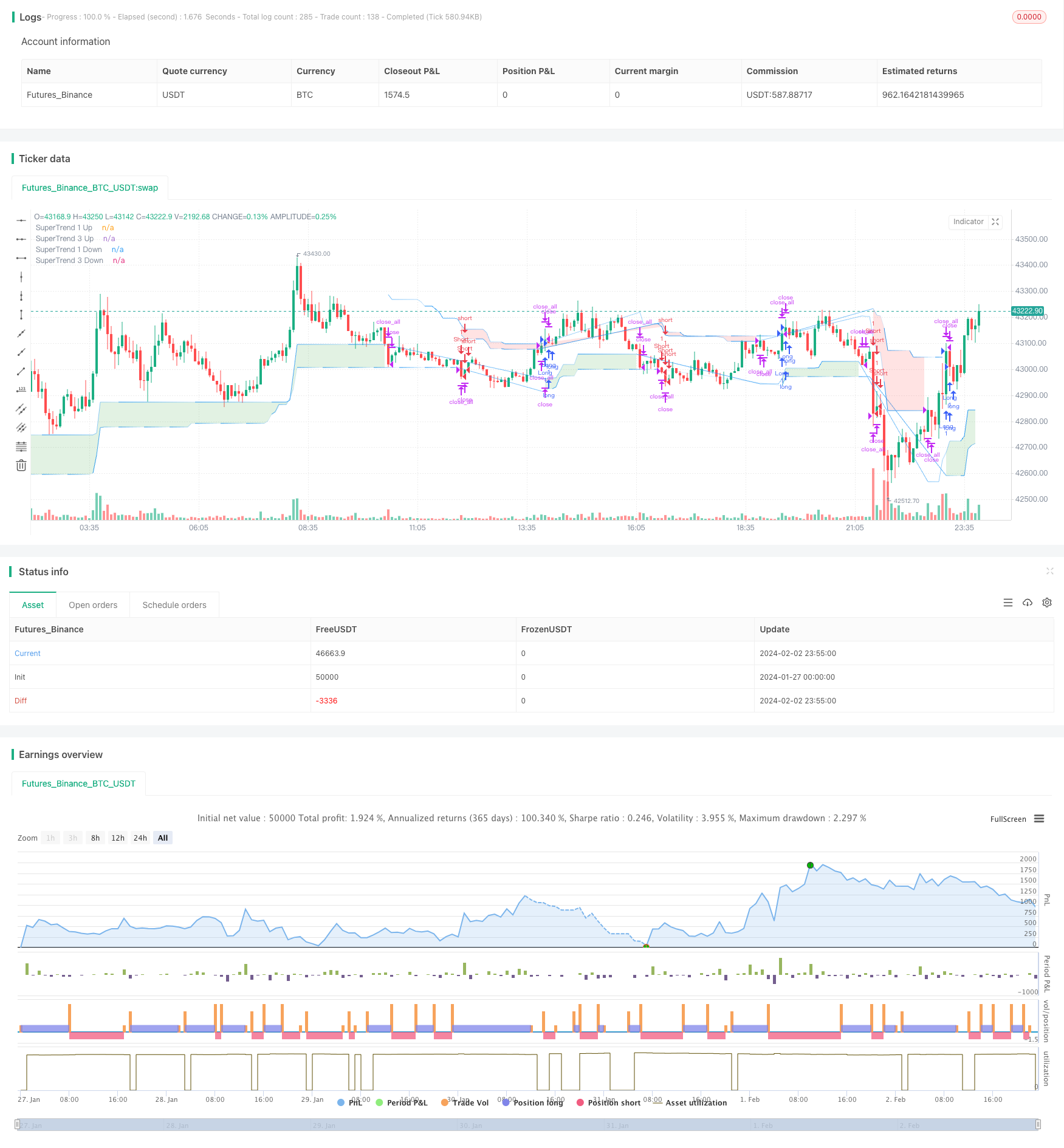Quadratic Momentum Double Indicators Timing Strategy
Author: ChaoZhang, Date: 2024-02-04 15:53:48Tags:

Overview
This strategy fuses the SuperTrend indicator with Elliott Wave theory to build a robust technical trading tool. It employs multi-level trend analysis to provide a more comprehensive market perspective that can early capture potential trend reversals and significant price moves.
Strategy Principle
The core idea lies in its multi-tiered approach:
- Use 4 SuperTrend indicators, each with different ATR lengths and multipliers, to judge the trend from short to long term
- Pinpoint robust long and short signals through indicator convergence
- Refer to Elliott Wave’s pattern recognition method to identify similar market behaviors to confirm trade signals
Thus, it utilizes multiple indicators and adds pattern recognition to make the strategy more robust.
Advantage Analysis
- Multi-indicator design provides comprehensive judgment
- Wave theory inspiration increases stability through pattern recognition
- Real-time direction adjustment adapts to market changes
- Configurable parameters suit different products and time frames
Risk Analysis
- Parameter setting relies on experience, requiring tuning to determine optimal parameter combinations
- Multi-indicator design is complex, increasing computational load
- Cannot completely avoid incorrect signal generation
Parameters can be optimized to gradually determine the optimum; cloud computing can improve computational performance; stop losses can control risk.
Optimization Directions
Optimizations can be made in several aspects:
- Add adaptive parameter adjustment module to dynamically tune parameters based on market conditions
- Incorporate machine learning models to aid in judging signal reliability
- Combine sentiment indicators, news events etc. to determine market regimes
- Support multi-product parameter templates to reduce testing workload
This will make strategy parameters more intelligent, judgments more accurate, and practical application more convenient.
Summary
The strategy comprehensively considers both trend and pattern dimensions, ensuring judgment robustness while increasing flexibility. Multi-indicators and parameter settings ensure full market applicability. With further incorporation of intelligent and automated methods, strategy practicality can be greatly enhanced. It provides valuable inspiration and reference for the advancement of technical trading.
/*backtest
start: 2024-01-27 00:00:00
end: 2024-02-03 00:00:00
period: 5m
basePeriod: 1m
exchanges: [{"eid":"Futures_Binance","currency":"BTC_USDT"}]
*/
//@version=5
strategy("Elliott's Quadratic Momentum - Strategy [presentTrading]",shorttitle = "EQM Strategy [presentTrading]", overlay=true )
// Inputs for selecting trading direction
tradingDirection = input.string("Both", "Select Trading Direction", options=["Long", "Short", "Both"])
// SuperTrend Function
supertrend(src, atrLength, multiplier) =>
atr = ta.atr(atrLength)
up = hl2 - (multiplier * atr)
dn = hl2 + (multiplier * atr)
trend = 1
trend := nz(trend[1], 1)
up := src > nz(up[1], 0) and src[1] > nz(up[1], 0) ? math.max(up, nz(up[1], 0)) : up
dn := src < nz(dn[1], 0) and src[1] < nz(dn[1], 0) ? math.min(dn, nz(dn[1], 0)) : dn
trend := src > nz(dn[1], 0) ? 1 : src < nz(up[1], 0)? -1 : nz(trend[1], 1)
[up, dn, trend]
// Inputs for SuperTrend settings
atrLength1 = input(7, title="ATR Length for SuperTrend 1")
multiplier1 = input(4.0, title="Multiplier for SuperTrend 1")
atrLength2 = input(14, title="ATR Length for SuperTrend 2")
multiplier2 = input(3.618, title="Multiplier for SuperTrend 2")
atrLength3 = input(21, title="ATR Length for SuperTrend 3")
multiplier3 = input(3.5, title="Multiplier for SuperTrend 3")
atrLength4 = input(28, title="ATR Length for SuperTrend 3")
multiplier4 = input(3.382, title="Multiplier for SuperTrend 3")
// Calculate SuperTrend
[up1, dn1, trend1] = supertrend(close, atrLength1, multiplier1)
[up2, dn2, trend2] = supertrend(close, atrLength2, multiplier2)
[up3, dn3, trend3] = supertrend(close, atrLength3, multiplier3)
[up4, dn4, trend4] = supertrend(close, atrLength4, multiplier4)
// Entry Conditions based on SuperTrend and Elliott Wave-like patterns
longCondition = trend1 == 1 and trend2 == 1 and trend3 == 1 and trend4 == 1
shortCondition = trend1 == -1 and trend2 == -1 and trend3 == -1 and trend4 == - 1
// Strategy Entry logic based on selected trading direction
if tradingDirection == "Long" or tradingDirection == "Both"
if longCondition
strategy.entry("Long", strategy.long)
// [Any additional logic for long entry]
if tradingDirection == "Short" or tradingDirection == "Both"
if shortCondition
strategy.entry("Short", strategy.short)
// [Any additional logic for short entry]
// Exit conditions - Define your own exit strategy
// Example: Exit when any SuperTrend flips
if trend1 != trend1[1] or trend2 != trend2[1] or trend3 != trend3[1] or trend4 != trend4[1]
strategy.close_all()
// Function to apply gradient effect
gradientColor(baseColor, length, currentBar) =>
var color res = color.new(baseColor, 100)
if currentBar <= length
res := color.new(baseColor, int(100 * currentBar / length))
res
// Apply gradient effect
color1 = gradientColor(color.blue, atrLength1, bar_index % atrLength1)
color4 = gradientColor(color.blue, atrLength4, bar_index % atrLength3)
// Plot SuperTrend with gradient for upward trend
plot1Up = plot(trend1 == 1 ? up1 : na, color=color1, linewidth=1, title="SuperTrend 1 Up")
plot4Up = plot(trend4 == 1 ? up4 : na, color=color4, linewidth=1, title="SuperTrend 3 Up")
// Plot SuperTrend with gradient for downward trend
plot1Down = plot(trend1 == -1 ? dn1 : na, color=color1, linewidth=1, title="SuperTrend 1 Down")
plot4Down = plot(trend4 == -1 ? dn4 : na, color=color4, linewidth=1, title="SuperTrend 3 Down")
// Filling the area between the first and third SuperTrend lines for upward trend
fill(plot1Up, plot4Up, color=color.new(color.green, 80), title="SuperTrend Upward Band")
// Filling the area between the first and third SuperTrend lines for downward trend
fill(plot1Down, plot4Down, color=color.new(color.red, 80), title="SuperTrend Downward Band")
- Willy Wonka Breakout Strategy
- Exponential Moving Average and Relative Strength Index Combination Trend Following Strategy
- Reversal Trend Catching and Dynamic Stop Loss Combo Strategy
- Golden Parabola Breakout Strategy
- SAR Momentum Reversal Tracking Strategy
- Dynamic RSI Trading Strategy
- Crossover Strategy between Multiple Moving Averages
- Dual Moving Average Breakout Strategy
- Moving Average Crossover Strategy
- Dual Moving Average Trend Tracking Strategy
- Renko and Relative Vigor Index Trend Following Strategy
- Swing Trend Moving Average Strategy
- Bollinger Band, Moving Average and MACD Combined Trading Strategy
- Momentum Price Climbing Crypto Currency Strategy
- Momentum Trading Strategy Based on Multi-factor Model
- Adaptive Bollinger Bands Trend Tracking Strategy
- Improved RSI Breakout Strategy with Stop Loss and Take Profit
- Quantitative Trading Strategy Based on RSI and Bollinger Bands
- Quantitative Trading Strategy Based on SMA and Rolling Trendline
- Stochastic Weekly Options Trading Strategy